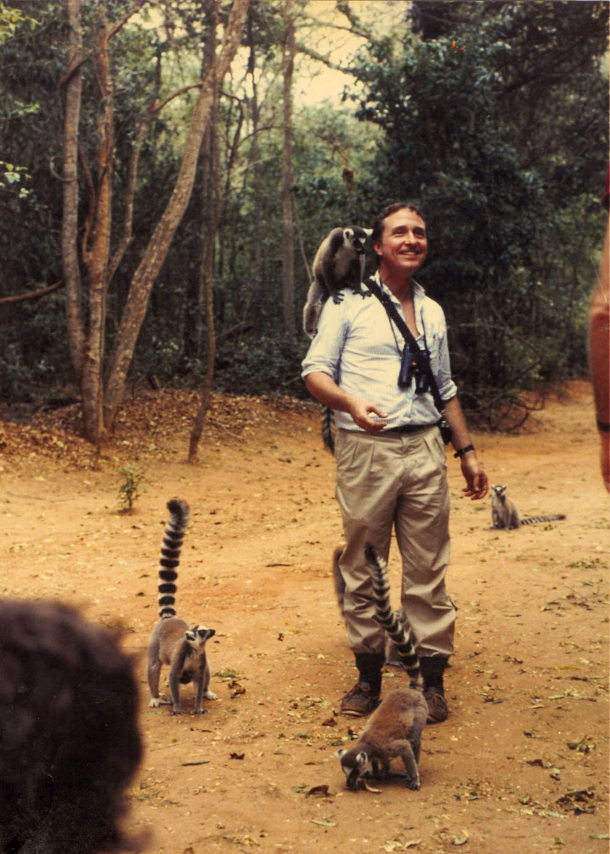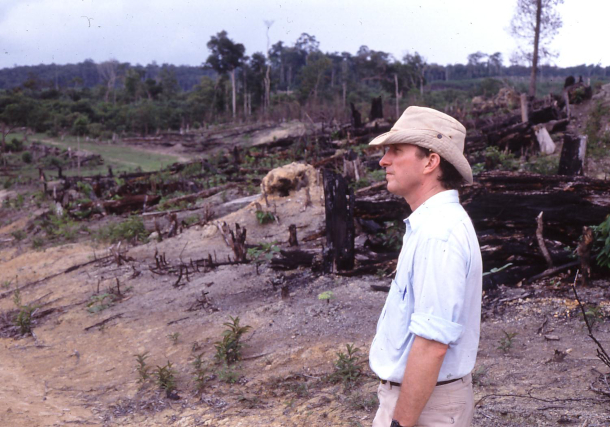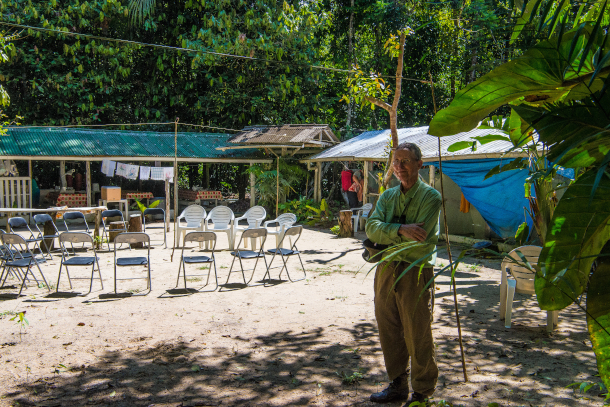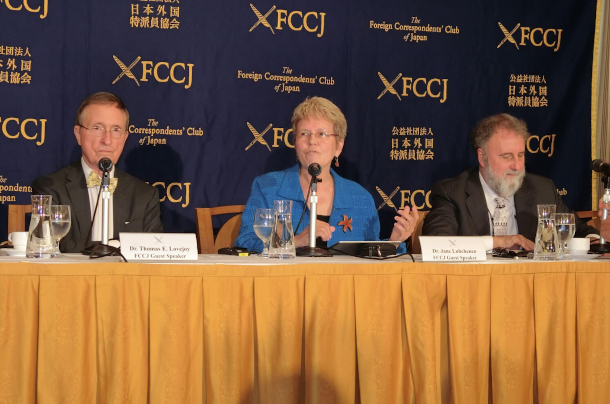Remembering Naturalist Tom Lovejoy
Air Date: Week of January 7, 2022
Ecologist Tom Lovejoy is being remembered for his decades of research and bringing people together to protect the Amazon rainforest and other ecosystems on the planet. (Photo: courtesy of Carmen Thorndike)
Host Steve Curwood and White House Deputy Director for Climate and Environment, Jane Lubchenco, continue their conversation about the legacies of leading naturalists E. O. Wilson and Tom Lovejoy. They discuss how ecologist Tom Lovejoy brought people together to help protect the planet, from the Amazon rainforest to a cabin on the outskirts of Washington, D.C.
Transcript
CURWOOD: It’s Living on Earth, I’m Steve Curwood.
Like E.O. Wilson, biologist Tom Lovejoy dedicated his career to not only studying life but also communicating the biodiversity crisis to the public. He spoke with Living on Earth back in 2010 about a growing awareness of this emergency, and UN efforts to deal with it. Let's share a clip from that interview.
LOVEJOY: I think what’s driving it today is a greater sense of urgency than before because people can see a lot of this biodiversity beginning to slip away. That finally makes you focus and spend less time negotiating and more time thinking about how to actually protect the biology of the planet and indeed the human future.
CURWOOD: Tom Lovejoy’s work focused on tropical rainforests and he was famous for showing the amazing diversity of life in the Amazon as well as telling about it. Over the years he hosted politicians including Vice President Al Gore and celebrities such as Olivia Newton-John at Camp 41, a research station deep in the Amazon where people slept in hammocks to reduce the odds of scorpions creeping into their sleeping bags. Around the station there were creatures and plants never before recorded by science in the Global North. And when I visited Camp 41 in 2002 and got to see a scientist document a previously unrecorded potoo, that’s a species of bird, I too went from seeing biodiversity as just an intellectual construct to feeling it as real and exciting. We’ve been talking about the legacies of Tom Lovejoy and E.O. Wilson with biologist Jane Lubchenco, who currently serves as deputy director of Climate and Environment in the White House. Jane, how did Tom Lovejoy shape our understanding of the importance of keeping this vital ecosystem intact?
Tom Lovejoy holding a Cecropia leaf at Camp 41 in the Amazon in 2014. (Photo: Slodoban Randjelovic)
LUBCHENCO: Tom first went to the Amazon as a graduate student, and he was focused on birds. And according to him, he just really fell in love with the whole rainforest. And at the time, there was increasing logging that was happening in the Amazon. And he quickly appreciated what a potential threat that was to the health of the rainforest ecosystems, not only to the birds that he cared about, but to the mammals and the insects and the trees, etc. And he was inspired, in fact, by the work that Ed Wilson and Robert MacArthur and Dan Simberloff had done on island biogeography. And he started thinking about, how does the size of the parcel that remains in the rainforest after logging happens affect the biodiversity? And at the time, there was a raging controversy in the conservation world, it was called the SLOSS debate, S-L-O-S-S, and it stood for "Single Large Or Several Small" parcels. And the question was, if you are in a position of creating habitat for biodiversity, is it better to have one single large parcel, let's say ten acres just for the sake of argument, or ten smaller, one acre parcels. And there were arguments on either side, having to do with, well, if it's a single parcel, wildfire, disease, might wipe out the whole thing; if it's divided up into smaller ones then at least some of them could persist. Versus the idea that some of the very large, very mobile critters, let's say a panther, for example, might need a very, very large habitat. And so you would lose those big charismatic species if you had only small parcels. So there was a debate. And Tom said, let's test this idea; this is the scientific approach. And so he worked with colleagues in Brazil, worked with landowners and the government and created this experiment that is still ongoing today. And it was created in the late '70s, I think, maybe '79. And the experiment was essentially to create parcels that were one, ten, or a hundred hectares, and then follow them through time and see how the biodiversity changed in those parcels. Those experiments have given us a huge amount of information about how size of the parcel affects the type of species that are there, and the health of the whole system. And in fact, there is no doubt that larger parcels are better. And so that early experiment of Tom's has yielded a huge amount of information that is guiding conservation action today.

Tom Lovejoy first went to the Amazon as a graduate student to study birds and fell in love with the whole rainforest. Here he is with a group of curious lemurs. (Photo: courtesy of Carmen Thorndike)
CURWOOD: So Tom Lovejoy was also well known for, for telling the story of the Amazon and biological diversity. And he attracted a swarm of politicians and celebrities who would either visit him in the Amazon or just pay attention to what he was doing and saying; what was Tom's skill there? How was it that he was able to, to bring these types of folks to the story of biological diversity and why we needed to, to hang on to it?
LUBCHENCO: Tom was a gifted communicator, but he was also a connector. And he understood people, he understood what would be of interest to someone. And he would very carefully make an argument to someone about why they should be interested in the Amazon or biodiversity or birds or whatever it was. So part of Tom's legacy is this gift that he had for sharing the excitement, enthusiasm, and passion that he had for nature with others, and in training them in this vision of respecting nature, protecting nature, living with nature. And he understood how important it was to do that with local people. Much of the work that he did in the Amazon was with Brazilian students, Brazilian scientists, Brazilian politicians also went to Camp 41. And so it was not a nature versus people thing. It was very holistic. And the same was, was true -- you know, Ed also appreciated the importance of, of working with people. But Tom in particular, really took that home and made it real. And now there are many, many young Brazilian scientists that are spectacular in part because they sort of got their start with Tom.

Lovejoy in a deforested section of Amazon rainforest c. early 1980s (Photo: courtesy of Carmen Thorndike)
CURWOOD: So Jane, if you could pick one memory from working with Tom Lovejoy, what would come to mind?
LUBCHENCO: Mmmm... I spent a lot of time with Tom in a lot of different venues. But I think his home, that he called Drover's Rest in McLean, Virginia, was a very special place. He often would have dinners there. Fantastic food, great wine; his wine cellar was quite extensive, and people knew that Tom was quite the oenophile. But he would gather unusual groups of people together and have these engaging conversations. Always a fire in the wintertime, fire going in the fireplace in this old cabin that just had a lot of character. And Tom was such a gifted host, everybody would be comfortable but he had given a lot of thought to the people he was introducing to one another, so it wasn't just the same group. Oftentimes, when I would be there, it would be everybody was new to me, or I might know only one other person. And so he was always matchmaking. And always with the idea of stimulating conversation that would be intriguing, interesting, we could learn from one another, but also result in some higher purpose focused on conservation, on nature, on big ideas, on getting something done. So, you never felt like you were being manipulated, it was always a very natural, very engaging enjoyment, and anybody who went to Drover's Rest would always say yes the next time because it was such a very special experience.

Tom Lovejoy at Camp 41 in the Amazon rainforest (Photo: Zachary Smith)
CURWOOD: It was, it was like in fact, being inside a, it reminded me of an old sailing ship, a big old sailing ship, that being inside that cabin that I was somehow in the captain's quarters in some big old ship with the big timbers there. And Tom always cracking a joke, not over the top, but just making light and having fun --
LUBCHENCO: Yep.
CURWOOD: -- with, I don't know how many bow ties the man owned, but not sure I saw the same one twice.
LUBCHENCO: He had a lot of bow ties. And that was always very special, because my dad was a bow tie guy too. The first time I saw Tom, I think I liked him just because he was wearing a bow tie!
CURWOOD: [LAUGHS] So how do you think Ed Wilson and Tom Lovejoy's work should be remembered?
Hammocks and mosquito nets in the sleeping quarters at Camp 41 (Photo: courtesy of Amazon Biodiversity Center)
LUBCHENCO: Well, both were gifted scientists. They took very different paths; Ed was an academic who did just one discovery after another after another. And then he came around to appreciating the biodiversity crisis and being a leader in saving biodiversity. Tom took a very different path. He was more a scientific adviser, a scientific communicator, an instigator of new conservation oriented things. So different paths, but they ended up very much in the same place of being champions for biodiversity, and eloquent communicators, through their writings, through their speaking, to motivate people to care about nature, and to help be part of the solution. Their legacy lives on, in our hearts, in our minds. And we need to do justice to their legacy by taking up the mantle of what they were working on. It's time for all of us to come together.

From left to right: Tom Lovejoy, Jane Lubchenco, and atmospheric scientist Bob Watson, all Blue Planet Prize recipients, speaking to the Foreign Correspondents Club of Japan in Tokyo 2017. (Photo: Blue Planet Prize of the Asahi Glass Foundation)
CURWOOD: Jane Lubchenco is a marine scientist and former president of the American Association for the Advancement of Science, among many honors, and she currently serves as the Deputy Director for Climate and Environment in the Biden White House. Thanks so much for taking the time with us today.
LUBCHENCO: Steve, it's just my pleasure. Thank you so much.
Links
Listen to the E.O. Wilson part of this interview
Elizabeth Kolbert for The New Yorker | “Honoring the Legacy of E. O. Wilson and Tom Lovejoy”
Listen to LOE’s 2010 interview with Tom Lovejoy on saving the world’s biodiversity
Jane Lubchenco’s statement paying tribute to E. O. Wilson and Tom Lovejoy
Living on Earth wants to hear from you!
Living on Earth
62 Calef Highway, Suite 212
Lee, NH 03861
Telephone: 617-287-4121
E-mail: comments@loe.org
Newsletter [Click here]
Donate to Living on Earth!
Living on Earth is an independent media program and relies entirely on contributions from listeners and institutions supporting public service. Please donate now to preserve an independent environmental voice.
NewsletterLiving on Earth offers a weekly delivery of the show's rundown to your mailbox. Sign up for our newsletter today!
 Sailors For The Sea: Be the change you want to sea.
Sailors For The Sea: Be the change you want to sea.
 The Grantham Foundation for the Protection of the Environment: Committed to protecting and improving the health of the global environment.
The Grantham Foundation for the Protection of the Environment: Committed to protecting and improving the health of the global environment.
 Contribute to Living on Earth and receive, as our gift to you, an archival print of one of Mark Seth Lender's extraordinary wildlife photographs. Follow the link to see Mark's current collection of photographs.
Contribute to Living on Earth and receive, as our gift to you, an archival print of one of Mark Seth Lender's extraordinary wildlife photographs. Follow the link to see Mark's current collection of photographs.
 Buy a signed copy of Mark Seth Lender's book Smeagull the Seagull & support Living on Earth
Buy a signed copy of Mark Seth Lender's book Smeagull the Seagull & support Living on Earth

